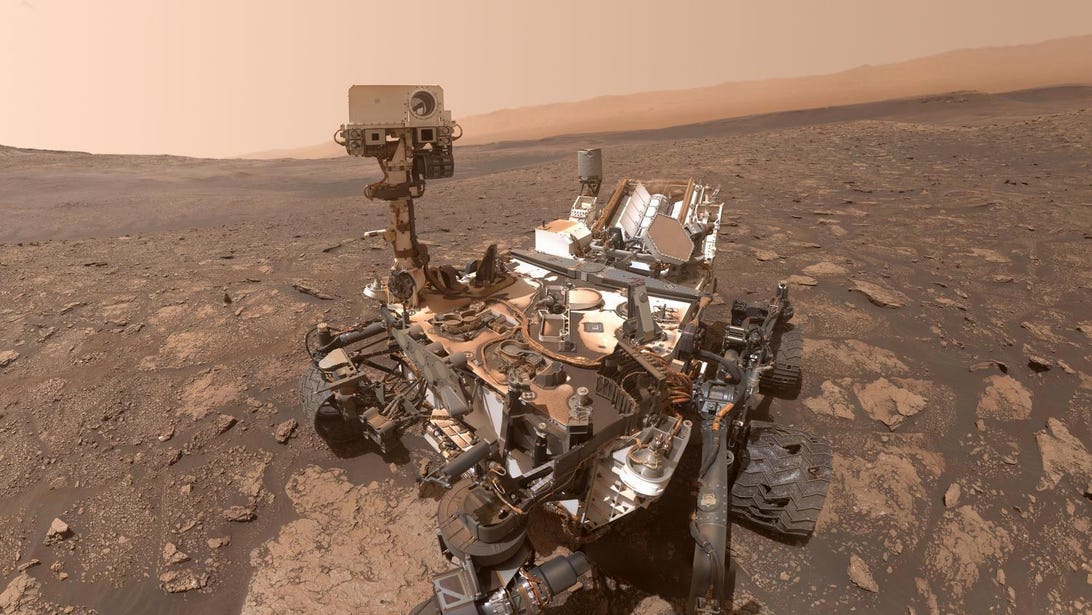
NASA's Curiosity rover snapped this selfie in 2020.
NASA/JPL-Caltech/MSSSMethane. On Earth, it's the stuff of cow farts and burps. On Mars, it's the stuff of mysteries. Scientists have been puzzling over methane readings from Mars, and NASA may be a step closer to figuring out what's going on with the gas on the red planet. It turns out the time of day has a big impact on methane detections.
Methane is particularly intriguing because it can be a byproduct of living things, including microbes. Researchers are trying to work out if Mars once hosted microbial life, or if microbes might possibly survive there now. But don't get too hyped; methane can also have a geologic origin.
What's weird about methane on the red planet is that NASA's Curiosity rover has detected the gas near the surface in the Gale Crater, but the European Space Agency's ExoMars Trace Gas Orbiter spacecraft isn't seeing methane higher up in the atmosphere. So what's going on?
Curiosity's Tunable Laser Spectrometer instrument is part of its Sample Analysis at Mars system, essentially a portable chemistry lab. Usually, TLS detects a small amount of methane NASA describes as "equivalent to about a pinch of salt diluted in an Olympic-size swimming pool." In 2019, TLS notably detected a considerable spike in methane levels.
The ExoMars orbiter, which arrived at Mars in 2016, hasn't been seeing what Curiosity sees. "But when the European team announced that it saw no methane, I was definitely shocked," TLS instrument lead Chris Webster said in a NASA statement on Tuesday.
Mars pits: Gaze into the abyss with these wild NASA images
See all photosThe discrepancy may come down to the times of day when the orbiter and rover work. The power-hungry TLS on the rover operates at night so it doesn't conflict with other instruments. The orbiter makes its detections during the day when it has sunlight to help it. What may be happening is that methane pools near the surface during calm nights and dissipates during the day, making it invisible to the spacecraft.
The Curiosity team tested this idea by taking daytime methane measurements, and indeed the gas disappeared during the day. The researchers published their findings today in the Astronomy and Astrophysics journal (PDF link).
While one methane mystery may have an explanation, another gassy conundrum lingers. NASA is still trying to sort out the "global methane puzzle at Mars." Methane released from Mars craters should remain stable enough -- and accumulate in the atmosphere enough -- for detection by the Trace Gas Orbiter.
Scientists are now looking into what might be destroying the methane. "We need to determine whether there's a faster destruction mechanism than normal to fully reconcile the data sets from the rover and the orbiter," said Webster. Until then, Mars methane will remain an enigma.
Follow CNET's 2021 Space Calendar to stay up to date with all the latest space news this year. You can even add it to your own Google Calendar.
https://news.google.com/__i/rss/rd/articles/CBMiVGh0dHBzOi8vd3d3LmNuZXQuY29tL25ld3MvbmFzYS1jdXJpb3NpdHktcm92ZXItbWF5LWhhdmUtc29sdmVkLW1hcnMtbWV0aGFuZS1teXN0ZXJ5L9IBX2h0dHBzOi8vd3d3LmNuZXQuY29tL2dvb2dsZS1hbXAvbmV3cy9uYXNhLWN1cmlvc2l0eS1yb3Zlci1tYXktaGF2ZS1zb2x2ZWQtbWFycy1tZXRoYW5lLW15c3Rlcnkv?oc=5
2021-06-30 00:57:01Z
52781701425417
Tidak ada komentar:
Posting Komentar